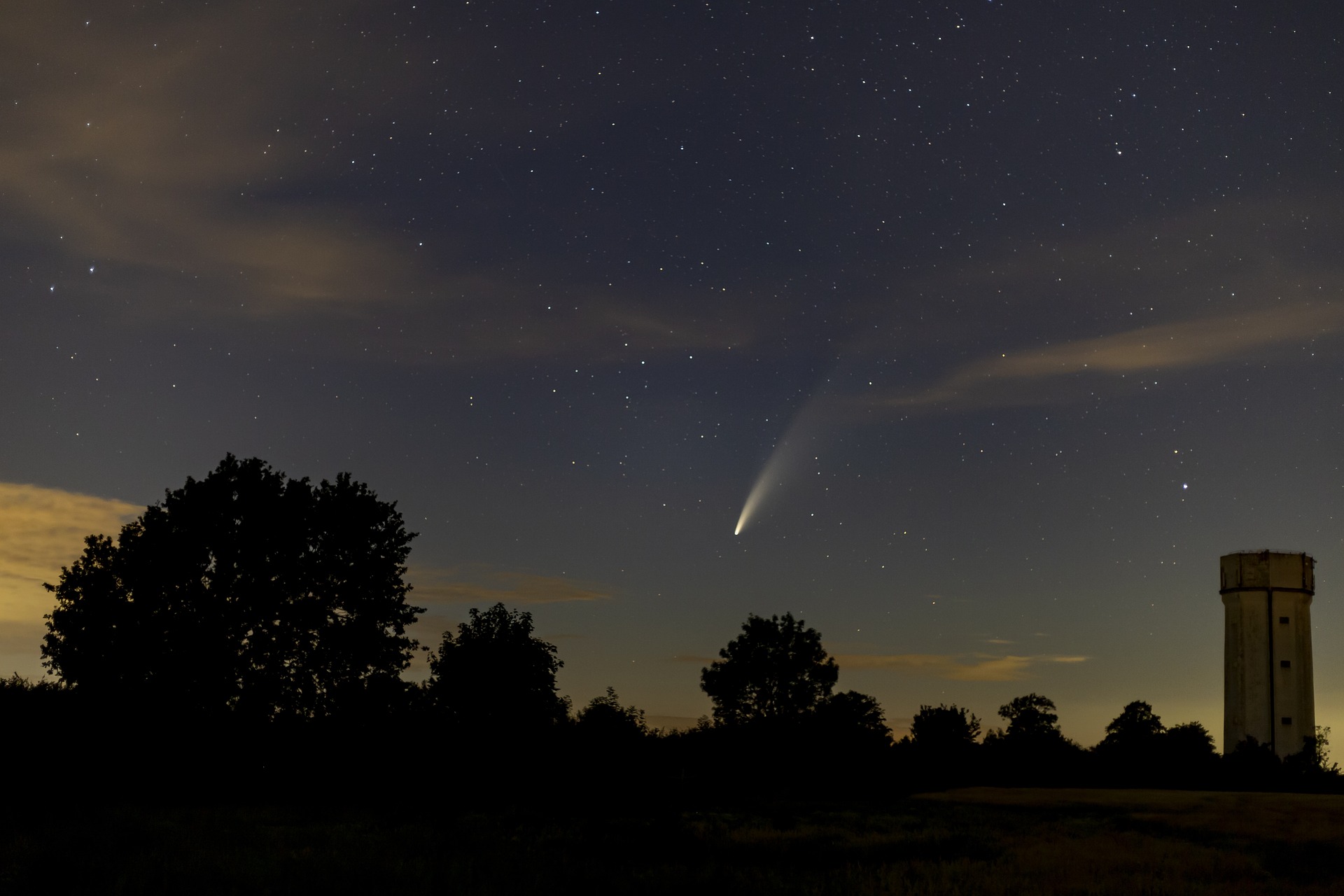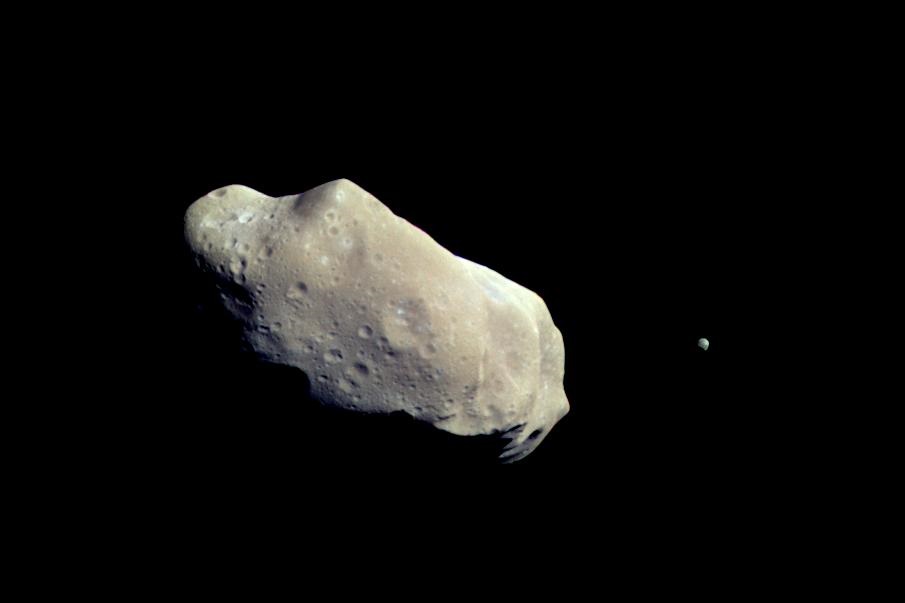Stardust and Eternity – 3.1.7
Minor Bodies of the Solar System
Besides the nine major bodies – the Sun and the eight major “terrestrial” and “jovian” planets – our Solar System is composed by a plethora of smaller orbiting objects, including asteroids, comets, trans-neptunian objects, and small planetary satellites and rings. These “minor bodies” mostly represent original planetesimal pieces, i.e. remnants from the time of Solar System’s formation – approximately 4.6 billion years ago – which never accumulated enough material to form proper planets.
Most of the known minor bodies (about one million) lie in an orbit between Mars and Jupiter, the so-called “asteroid belt”, taking three to six years to make a complete revolution around the Sun. Moreover, tens of thousands of them are actually near-Earth objects that can potentially approach our planet more or less closely, posing a potential threat – if large enough – to human life. A well-known example is the 10 km asteroid that impacted the Yucatan Peninsula in Mexico about 66 million years ago, bringing the dinosaur era to an abrupt end. Astrophysicists suggest that some of the water and organic compounds that can be found on Earth actually come from asteroid impacts: this is why these bodies can be rightly considered as celestial bringers of both life and death! Asteroids are relatively small, rocky or metallic objects without an atmosphere, whose size ranges from a few meters up to hundreds of kilometers; their combined mass is less than that of our Moon. Ceres, the largest known asteroid – about 1,000 km in diameter – is now classified as the only “dwarf planet” within Neptune’s orbit.
Similarly to asteroids, “comets” are relatively small (up to a few kilometres) “dirty snowballs” that revolve around the Sun in highly elliptical orbits and represent remnants from the time of the Solar System formation. They mostly originate from a doughnut-shaped region located at the edges of the Solar System, composed by millions of so-called “trans-neptunian” – beyond Neptune – objects: when one of these frozen rocks is perturbed by the gravity of another object, it is thrown into the inner Solar System and becomes a comet. Unlike asteroids, comets are characterized by the presence of an extended “atmosphere” of ice and dust which is loosely bound and forms their typical tails as they approach the Sun. This phenomenon occurs because solar radiation causes the volatile icy materials – mostly water – inside the comet to vaporize in a tenuous atmosphere, which is called “coma”. The particles expelled by the comet are pushed away from the Sun by the solar radiation pressure and wind, regardless of the direction in which the comet is moving. After several revolutions around the Sun, comets are doomed to increasingly vaporise and eventually break apart completely.
Although asteroids, comets and transneptunian objects numerically constitute the vast majority of the so-called minor bodies of the Solar System, hundreds of planetary satellites or moons around the major planets are known – besides Mercury and Venus – together with their systems of rings. Among these moons, only three of them – i.e. our Moon and Mars’ Phobos and Deimos – orbit terrestrial planets. Other satellites orbit outer gaseous “jovian” planets. Jupiter and Saturn each have around 80 known moons, with Jupiter’s Ganymede being the largest moon of the Solar System – it is slightly larger than Mercury – and Saturn’s Titan being the second largest natural satellite. Titan is the only moon in the solar system that has a dense atmosphere, as well as the only known celestial body with rivers, lakes, and seas (albeit of liquid ethane and methane) on its surface.
Finally, the four jovian planets display systems of rings, the most spectacular being that of Saturn, approximately 400,000 km wide and with a thickness ranging from hundreds of metres to a few kilometres; the rings consist of countless small particles, which can be up to several metres in size, composed almost entirely of iced water and a few traces of rocky material.
Further Resources
Links below will redirect you to external websites. In accordance with the European data protection declarations, we would like to point out that by clicking on these links you may send data to external providers. We cannot prevent that.
Images
![]() The Galilean satellites (Kenneth R. Lang, Tufts University)
The Galilean satellites (Kenneth R. Lang, Tufts University)
![]() Asteroid Belts (Illustration) (NASA, ESA, Joseph Olmsted (STScI)
Asteroid Belts (Illustration) (NASA, ESA, Joseph Olmsted (STScI)
![]() 42 asteroids imaged by ESO’s VLT (ESO/M. Kornmesser/Vernazza et al./MISTRAL algorithm (ONERA/CNRS)
42 asteroids imaged by ESO’s VLT (ESO/M. Kornmesser/Vernazza et al./MISTRAL algorithm (ONERA/CNRS)
![]() Size comparison of asteroid Kleopatra with northern Italy (ESO/M. Kornmesser/Marchis et al.)
Size comparison of asteroid Kleopatra with northern Italy (ESO/M. Kornmesser/Marchis et al.)
![]() Predicted position of `Oumuamua versus observed position (ESA)
Predicted position of `Oumuamua versus observed position (ESA)
![]() Asteroid 2000 PH5 (ESO)
Asteroid 2000 PH5 (ESO)
Videos
![]() Asteroids: Crash Course Astronomy
Asteroids: Crash Course Astronomy
![]() Asteroids: Threats from Cosmos (SPACETIME – SCIENCE SHOW)
Asteroids: Threats from Cosmos (SPACETIME – SCIENCE SHOW)
![]() Jupiter’s Moons: Crash Course Astronomy
Jupiter’s Moons: Crash Course Astronomy
![]() The Oort Cloud: Crash Course Astronomy
The Oort Cloud: Crash Course Astronomy
![]() First Interstellar Visitors to the Solar System (ESO)
First Interstellar Visitors to the Solar System (ESO)
 I CORPI MINORI DEL SISTEMA SOLARE – Antonio Loiacono
I CORPI MINORI DEL SISTEMA SOLARE – Antonio Loiacono
 Asteroidi e comete – HUB Scuola
Asteroidi e comete – HUB Scuola
 Le Comete – Rai Edu 1
Le Comete – Rai Edu 1
 Le Comete: caratteristiche, movimenti e differenze – Scienza channel TV
Le Comete: caratteristiche, movimenti e differenze – Scienza channel TV
 Gli Asteroidi – Rai Edu 1
Gli Asteroidi – Rai Edu 1
 Giove ed i suoi satelliti – Rai Edu 1
Giove ed i suoi satelliti – Rai Edu 1
 Saturno ed i suoi satelliti – Rai Edu 1
Saturno ed i suoi satelliti – Rai Edu 1
Online Resources
 Altri corpi celesti del Sistema Solare – INAF – Brera
Altri corpi celesti del Sistema Solare – INAF – Brera
Further Readings
![]() Dwarf Planets and Asteroids: Minor Bodies of the Solar System (Thomas W. Hamilton)
Dwarf Planets and Asteroids: Minor Bodies of the Solar System (Thomas W. Hamilton)
![]() Moons of the Solar System (Thomas W. Hamilton)
Moons of the Solar System (Thomas W. Hamilton)
![]() Rock Legends: The Asteroids and Their Discoverers (Paul Murdin)
Rock Legends: The Asteroids and Their Discoverers (Paul Murdin)
![]() Asteroids: Relics of Ancient Time (Michael K. Shepard)
Asteroids: Relics of Ancient Time (Michael K. Shepard)
![]() Asteroids: A History (Curtis Peebles)
Asteroids: A History (Curtis Peebles)
![]() Asteroids, Meteorites, and Comets (Linda T. Elkins-Tanton)
Asteroids, Meteorites, and Comets (Linda T. Elkins-Tanton)
 I CORPI MINORI DEL SISTEMA SOLARE (Claudio Elidoro)
I CORPI MINORI DEL SISTEMA SOLARE (Claudio Elidoro)
Teaching Material
![]() Exploring meteorite mysteries teacher’s guide (NASA)
Exploring meteorite mysteries teacher’s guide (NASA)
 I corpi minori del Sistema Solare (INAF – Vincenzo Orofino)
I corpi minori del Sistema Solare (INAF – Vincenzo Orofino)
 Pianeti e corpi minori del Sistema Solare – Antonella Mortaro
Pianeti e corpi minori del Sistema Solare – Antonella Mortaro
For Kids
![]() Comets and Asteroids! (video)
Comets and Asteroids! (video)
 Paxi – Rosetta e le comete (video)
Paxi – Rosetta e le comete (video)
 LE COMETE… In 2 minuti (video)
LE COMETE… In 2 minuti (video)
 Perché le comete hanno la coda? (video)
Perché le comete hanno la coda? (video)
 Comete (ESA – Space for Kids)
Comete (ESA – Space for Kids)
 Gli asteroidi spiegati ai bambini: una piccola guida (Nostrofiglio.it)
Gli asteroidi spiegati ai bambini: una piccola guida (Nostrofiglio.it)


